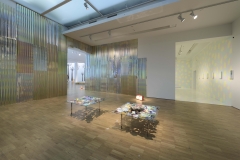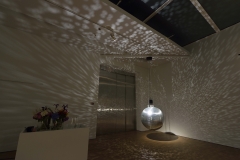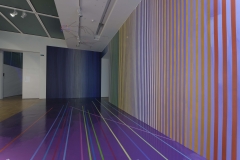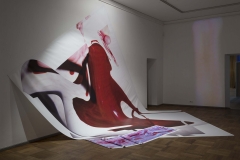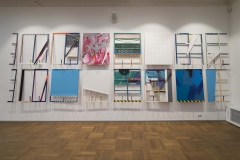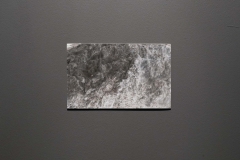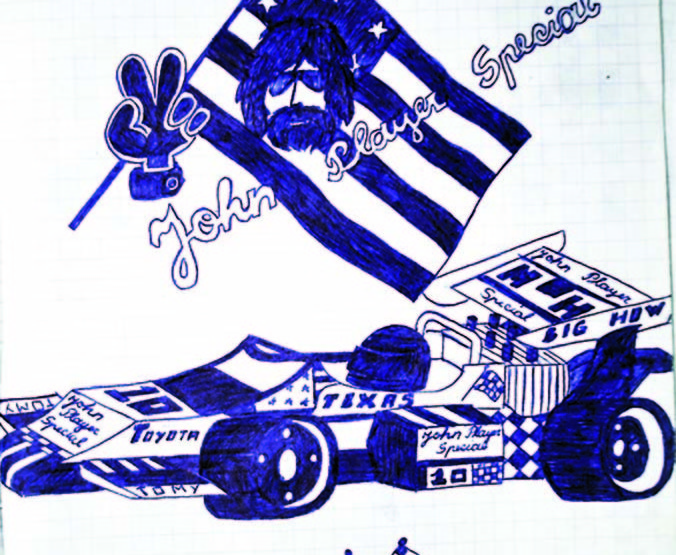Eha Komissarov (EK): A heated discussion recently took place on Facebook about young artists and their paintings. Some remarks were really harsh and we should look at them more closely. Here are some of the more colourful opinions: the art of today’s youth is totally pointless, it does not address any problems, painting has been reduced to a decorative splotch, do we want this kind of art, we miss the social stuff, etc.
Maria-Kristiina Soomre (MKS): The main issue on Facebook was that all young artists seemed to have been ‘forced’ to produce trend art; trend art is defined by these exhibitions at Kumu and at the Art Hall. There is no longer any social art with some sense to it (which at some point in the past was of course accused of being a trend). I have to admit that when I read Katrin Koskaru’s text in the catalogue [Can’t go on – Ed] about her own work, it seemed the most social painting project of the past ten years.
EK: The same goes for Anna Škodenko. But they stand out from the general scene. I am intrigued by why they came together in the Art Hall in the first place. Can’t go on aimed to replace pictorial painting with site-specific painting installations. They wished to get rid of the rhetoric of the supremacy of painting, separate themselves from the Art Hall previous art policy that valued painting and tirelessly demanded paintings above all else hanging over the Art Hall like a political axe and claimed that we no longer have curators, only painters**. The Can’t go on project we are now talking about was started under conditions prevalent two years ago. As everybody wrote in their texts, they were dissatisfied and tried to make their own move. The task of the curators (Elin Kard and Mihkel Ilus) was basically to direct the process.
MKS: I had exactly the same question when I pondered the topic of painting, for example on the basis of the Can’t go on exhibition: the Art Hall as an institution currently displays only paintings (besides Can’t go on, there is Kristi Kongi in the City gallery and Kaido Ole in the Art Hall gallery). Painting is declared programmatically. This seems to be a counter-wave, and the pendulum has swung to the other extreme. The previous equally declarative painting exhibition within the paradigm of contemporary art was No Painting!, curated by Anders Härm (Tallinn Art Hall, 2005). These two are the extremes on the scale. I am slightly annoyed by focusing on the medium in art as an exhibition practice and also as a kind of form of organisation. Until we get rid of these internal borders, we cannot really talk about art. We sit in our separate rooms and talk about ‘and what are the painters getting up to now’ and, inevitably, such exhibitions organised ‘between ourselves’ are in danger of discounting and creating a collegial bubble.
Marten Esko (ME): As an example from the Can’t go on exhibition, we should mention the work of Mihkel Ilus, who has claimed that he wishes to explore the features of materials and that he is tired of all allegories and depicting only surfaces, which can be more broadly linked with the entire previous discourse of painting. Opposing the previous discourse characterises the entire exhibition at the Art Hall.
EK: In our context, we are interested in painters who are in dialogue with their medium and see potential in themselves to develop a narrow and more exclusive trend of painting. Can’t go on represents such a painter’s position and if we have to criticise the participants for something we could mention instability. Two painting exhibitions happened to coincide, both realising the hotter trends in painting, although only one managed not to leave loose ends and carried out the principle of installation very clearly. Can’t go on would certainly have had a much bigger resonance if Estna’s exhibition at the Kumu Art Museum had not interfered with its totally different art experience. The initial idea of this exhibition was of a collective project. Merike Estna would arrive with a group of other artists and her Goldsmiths [College] friends in order to create a kind of communication project, and the installations would develop a more contemporary form of symbiosis: all this she managed remarkably well. For them, organising an exhibition of the paintings of the new generation was an easy and jolly cooperation, where nobody fought against anything at all and all simply enjoyed themselves. The artists did not seek a key to new art; instead, they were in dialogue amongst themselves, creating bridges of ideas. However, it makes no sense to use Estna to punch the Can’t go on in the face. The opportunities and experience are far too different for that.
MKS: The only thing that moved me about Estna’s exhibition was the total deep cleansing of the room accomplished by simply splashing it with pink foam, something which Can’t go on did not do.
EK: There was no cooperation at the Can’t go on exhibition: everybody sat quietly in his/her corner, doing his/her own thing. Here, art innovation had a different focus. Still, I do not deny the necessity of such a manner of doing things. One of the weak points of the Can’t go on was that artists aspired to renewal in their own agenda, without thinking that in this place innovation is often not really newsworthy. Maybe I am influenced by the recent 80th anniversary of the Art Hall but the possibilities of its spatial programmes are exhausted; e.g the ‘altar’, with Kristi Kongi’s installation in front of it, routinely designs the solutions. The young painter Kristi Kongi wishes to transform the two-dimensional picture format into a three-dimensional spatial installation; she has worked out a system that starts repeating various stamps of other works produced for this place. During the fifty years of the modernist Art Hall and the subsequent postmodernist Art Hall, all possibilities have already been played through. Since the planned renovation work has not yet started, I advise the new Art Hall management [since 1 December 2014 the Art Hall director has been Taaniel Raudsepp] to undertake a project that will deconstruct some rooms, which would then eliminate the traces of conventional exhibitions that have been held there.
MKS: At that exhibition Mart Vainre in fact took a step in that direction.
EK: His work is truly excellent, showing the tensions between the artist’s aspirations and reality. Like the rest of the group, Vainre relied on installation, but his starting point is an ironic relationship between himself and the house, which points to the opposition between real and simulated places.
ME: For me, both exhibitions pose the essential questions of a painter’s position. Estna’s exhibition evokes questions and constructions, such as ‘I’ as a painting, the borders of painting, space as a painting, floor as a painting, everything as a painting. At the same time, the Can’t go on‘s title says it all: cannot go on, but must go on. Once you have reached a certain position as a painter, where painting is the most valued medium in the market, but still secondary within the art field itself, then you wonder how to proceed or how to return. Return is not a good word, but painting seems to be in eternal return; it returns every year, as if this was a natural part of this medium. Renewal may be the only way forward. Renewing the local art field happens, although by adopting some Western tendencies.
EK: I really hope this is a dialogue matured inside a culture that was tested here. We could find various explanations; firstly, we continue the fight against the usual picture format, which began in the 1990s. Secondly, as the Estonian new painting of the last decade considered the market demands, an interest in creating more conceptual painting projects involving the whole room is most welcome.
ME: Kongi, Ilus and Vainre have tackled this theme for years, and have increased the format.
EK: In that sense, Koskaru is quite fascinating because she is producing Western minimalism, which is romantic and cool.
Liina Siib (LS): One participant of the Can’t go on, Mihkel Maripuu declares that he no longer wants to paint in a realistic or figural manner, as he is totally fed up with that. He is trying to find anonymous images on the internet, which he then enlarges, assembles and prints digitally; he is a representative of post-internet art.
EK: I have nothing against this personally, but he should pay a little attention to how he formats the result. If the work is in the usual vinyl banner format and he displays it according to the rules of a painting gallery, he ends up creating a super-decorative pointless blotch. For me, painting on the theme of post-internet art in 2014 does not seem a very convincing concept: the 21st century is quite picture-focused thanks to the internet. I cannot imagine how anyone can differentiate whether this is my image or an internet image.
MKS: The public is largely glued to the internet. The painters I know use the internet perhaps once a day. Parallel worlds exist today as well.
EK: Katja Novitskova works actively in graphic design. Her art is design-based, but Maripuu comes with a painting-based attitude, which seems a sort of brainwashing through internet images, and then the banners are printed. This is all very nice, but he should find more visual solutions, and move towards spatial thinking.
ME: In that sense, Katja is quite similar to Mihkel, as she also deals with photographs from the internet, although they are printed on aluminium. It is important here what the artist calls himself: a painter or a post-internet artist. Katja does not consider herself a painter. I assume Mihkel Maripuu tried to create a spatial environment full of internet noise through the painting discourse. The thing is that the traditional environment of the Art Hall resists this; it is impossible to produce noise there, because the room will still dominate. All that parquet, skirting boards and of course the history of the building. Maripuu’s MA project functioned much better at the exhibition in the Hobusepea gallery (2014), where the marble tile, and other ‘digital’ and printed materials were all mixed up, aided by a video projection, no longer of a photograph or video, but of a gif.
EK: I know several internet people for whom it is easy and natural to read Maripuu’s discourse at that exhibition.
ME: For me it is not easy or natural. In a sense I understand its confusion, as the internet is by no means curated either.
EK: Noise is a hugely fascinating topic. What does it mean? Noise operates in the form of error; it is an error, the result of a mistake or chance, and I would really like to see a painter tackle such things. Painting, after all, is essentially orderly, organising and decorative, and it would be fantastic to move from that into noise!
ME: This also implies that the artist should be critical. The drawback of this exhibition is perhaps that it has more poetry than criticism.
EK: Škodenko and Koskaru, characterised at the exhibition by an ability to generalise, took the much more fascinating position of observer or critic. The currently prevailing conservative time appreciates the discourse of formal beauty. Lyrical and metaphysical subjectivity, pushed aside in painting in the 1990s, has reappeared. I quite liked that pretty and poetic painting was opposed on Facebook by social art. The voice of this kind of public was a totally new experience for me.
LS: Strange that people suddenly demanded social art. This was not regarded as art before.
ME: It has changed now.
MKS: It is thus true that the people’s voice opposes something new and unknown arriving en masse, seeing it as dangerous.
EK: I was completely overwhelmed by this. A tradition exists and has proved itself magnificently, so that no target group can think about Estonian art without thinking about the social or critical author’s position.
MKS: Although content was crucial there, we assume that people were looking for an opinion, a stand, but perhaps they were looking for a narrative. When an artist does not take a pick, but a scalpel to the supporting pillars of his medium and asks significant questions for another painter, it may simply not be evident to the public.
EK: It is not easy to use a scalpel in a field where there is a huge amount of whatever you intend to tackle. Every housewife today is an abstract artist. “I don’t want flowers; I want colours like Estna had. There is a lot of talk about blotches, and these blotches are important to me.” I can quite understand why some avoid painting, because you are inevitably in dialogue with wallpaper, dress patterns, colour programmes etc. And then this person turns up with his scalpel and says he is dissatisfied and wants to change something. Nice, isn’t it?
LS: For me Estna’s exhibition included design as well.
EK: Yes, it is the broader theme of how to establish yourself with various means of painting. At Estna’s exhibition, one large general overview prevailed, and heaven knows what happened within, how many dialogues and weird absurd moves, such as fruit painted on stones. The large number and strangeness of visuals produced a strong impression, experiences and messages. In the catalogue, Merike Estna says that today’s painting is no longer exceptional and special.
“/…/ And, anyway, contemporary painting has been redefined on the basis that it is no longer in a secluded position, which also means that the media are mixing in ways that are also determined by the individual approaches of other kinds of artists. Whatever it is that defines painting it has moved beyond being defined by any pre-conceived ideas about what art is, or what painting means in any traditional art historical sense…
But actually I was even more focused on the question of how painting is interpreted or given a cultural value once it establishes a new ground or at least a less secluded position in this world.
These are the questions I have been working on, and the questions that characterize the work of many artists, painters or whatever we choose to call ourselves, who have emerged into a world in which the ‘expanded field of painting’, and not only painting, has already been achieved.” (From the text Dear I’m a Painting / Always yours Blue Lagoon by Merike Estna).
ME: At the Can’t go on exhibition all works seem separate from others, independent or solitary. At Estna’s exhibition, works were even on top of one another, relating to one another physically.
MKS: I like the notion of a dialogue. There is a huge mass together, a buzz; a kind of communication seems to be taking place, but it is not observed, and it is difficult for the viewer to notice scraps of conversation.
EK: Estna’s works were like impressionist paintings in the context of the 21st century, with a special level, and liberated from the tensions of the local school. Colours and intrigue were appreciated, the general visual impression, saturated with all manner of experience, was guaranteed from start to finish. Can’t go on did not aim to achieve synergy; we see intellectual aspirations and a wish to get something done, some kind of laboratories are operating that as a rule do not support one another.
ME: You could feel at Estna’s exhibition that they were all friends, with a certain synergy. People knew one another. It is not so noticeable at the Art Hall. As professional painters they discuss matters, but might not communicate much outside this platform. Everybody is doing his own thing.
EK: The topic of synergy is fascinating, and it worked for Estna. Why does this matter to curators, and why do curators commission such things? The form of cooperation where the group members address one another and together try to find suitable solutions seems to be the most productive one in terms of succeeding in place-specific art. This kind of working form is by no means available to friends only; the synergy must be produced by suppressing oneself to some extent and relating to others.
MKS: I agree. This experience is a bit missing in the field or it is artificially provided. On the other hand, speaking in a kind of apocalyptic sense, it does not really matter any more. But, pragmatically, somewhere the ordinary art life is ticking away; in art politics we increasingly aspire outward and want our artists to get two steps ahead of the Cultural Endowment’s project-based normality. As for the Art Hall, I have thought that this might be the only area where an artist could work so that he produced the bulk of his works and filled a big room, just him alone. This is the biggest problem for even the strongest Estonian artists. They could have a large-scale personal exhibition in a prestigious European exhibition house, but they would not have enough works to fill one floor. The art-political task of the Art Hall could be – as indeed it used to be – to organise personal exhibitions even if an artist has not quite finished or is not celebrating a major anniversary.
* the exhibitions Merike Estna and I’m a Painting at the Kumu Art Museum, 27.06.–02.11.14 (henceforth Estna), and Can’t go on, must go on 25.10.–30.11. 2014 at the Tallinn Art Hall (henceforth Can’t go on).
** The Tallinn Art Hall politics is about to change under the new direction led by Taaniel Raudsepp.
Merike Estna and I’m a Painting at the Kumu Art Museum
Can’t go on, must go on at the Tallinn Art Hall




